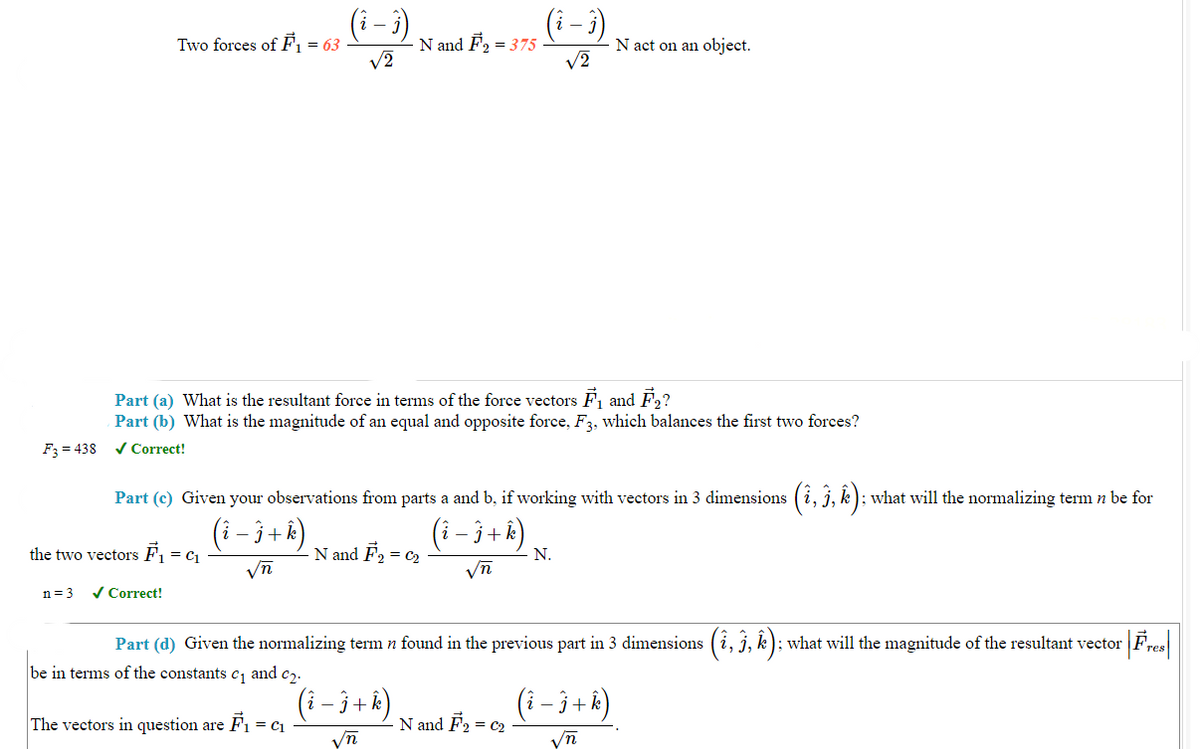Part (a) What is the resultant force in terms of the force vectors F₁ and F₂? Part (b) What is the magnitude of an equal and opposite force, F3, which balances the first two forces? F3=438 ✔Correct! Part (c) Given your observations from parts a and b, if working with vectors in 3 dimensions (1, 3, k): what will the normalizing term (i − j + k) √n the two vectors F₁ = C₁ n=3 ✓ Correct! (i - 3 + k) √n F₁ = C₁ -N and F₂ = C₂ Part (d) Given the normalizing term n found in the previous part in 3 dimensions (2, 3, k); what will the magnitude of the resultant ve be in terms of the constants c₁ and c₂. (i − j+ k) n The vectors in question are. N. N and F₂ = C₂ (i −3+ k) √n
Part (a) What is the resultant force in terms of the force vectors F₁ and F₂? Part (b) What is the magnitude of an equal and opposite force, F3, which balances the first two forces? F3=438 ✔Correct! Part (c) Given your observations from parts a and b, if working with vectors in 3 dimensions (1, 3, k): what will the normalizing term (i − j + k) √n the two vectors F₁ = C₁ n=3 ✓ Correct! (i - 3 + k) √n F₁ = C₁ -N and F₂ = C₂ Part (d) Given the normalizing term n found in the previous part in 3 dimensions (2, 3, k); what will the magnitude of the resultant ve be in terms of the constants c₁ and c₂. (i − j+ k) n The vectors in question are. N. N and F₂ = C₂ (i −3+ k) √n
Principles of Physics: A Calculus-Based Text
5th Edition
ISBN:9781133104261
Author:Raymond A. Serway, John W. Jewett
Publisher:Raymond A. Serway, John W. Jewett
Chapter1: Introduction And Vectors
Section: Chapter Questions
Problem 48P: Use the component method to add the vectors A and B shown in Figure P1.34. Express the resultant A+B...
Related questions
Question
Please answer part a and part d

Transcribed Image Text:Two forces of F₁ = 63
n=3
✓ Correct!
Part (a) What is the resultant force in terms of the force vectors F₁ and F₂?
Part (b) What is the magnitude of an equal and opposite force, F3, which balances the first two forces?
F3=438 ✔Correct!
(1-2) No
√2
Part (c) Given your observations from parts a and b, if working with vectors in 3 dimensions (î, ĵ, k): what will the normalizing term n be for
(²-3+k)
the two vectors F₁ = C₁
(1-3+k).
N and F₂ = C₂
√n
√n
be in terms of the constants c₁ and ₂.
The vectors in question are F₁ =
N and F₂ = 375
= C1
(1-2)
√2
Part (d) Given the normalizing term n found in the previous part in 3 dimensions (2, 3, k); v
; what will the magnitude of the resultant vector
1 | Fres |
( i − j + k)
√n
N and F₂ = C₂
N act on an object.
N.
(1-3+k)
√n
Expert Solution
This question has been solved!
Explore an expertly crafted, step-by-step solution for a thorough understanding of key concepts.
Step by step
Solved in 2 steps with 2 images

Knowledge Booster
Learn more about
Need a deep-dive on the concept behind this application? Look no further. Learn more about this topic, physics and related others by exploring similar questions and additional content below.Recommended textbooks for you

Principles of Physics: A Calculus-Based Text
Physics
ISBN:
9781133104261
Author:
Raymond A. Serway, John W. Jewett
Publisher:
Cengage Learning

Glencoe Physics: Principles and Problems, Student…
Physics
ISBN:
9780078807213
Author:
Paul W. Zitzewitz
Publisher:
Glencoe/McGraw-Hill

Physics for Scientists and Engineers, Technology …
Physics
ISBN:
9781305116399
Author:
Raymond A. Serway, John W. Jewett
Publisher:
Cengage Learning

Principles of Physics: A Calculus-Based Text
Physics
ISBN:
9781133104261
Author:
Raymond A. Serway, John W. Jewett
Publisher:
Cengage Learning

Glencoe Physics: Principles and Problems, Student…
Physics
ISBN:
9780078807213
Author:
Paul W. Zitzewitz
Publisher:
Glencoe/McGraw-Hill

Physics for Scientists and Engineers, Technology …
Physics
ISBN:
9781305116399
Author:
Raymond A. Serway, John W. Jewett
Publisher:
Cengage Learning